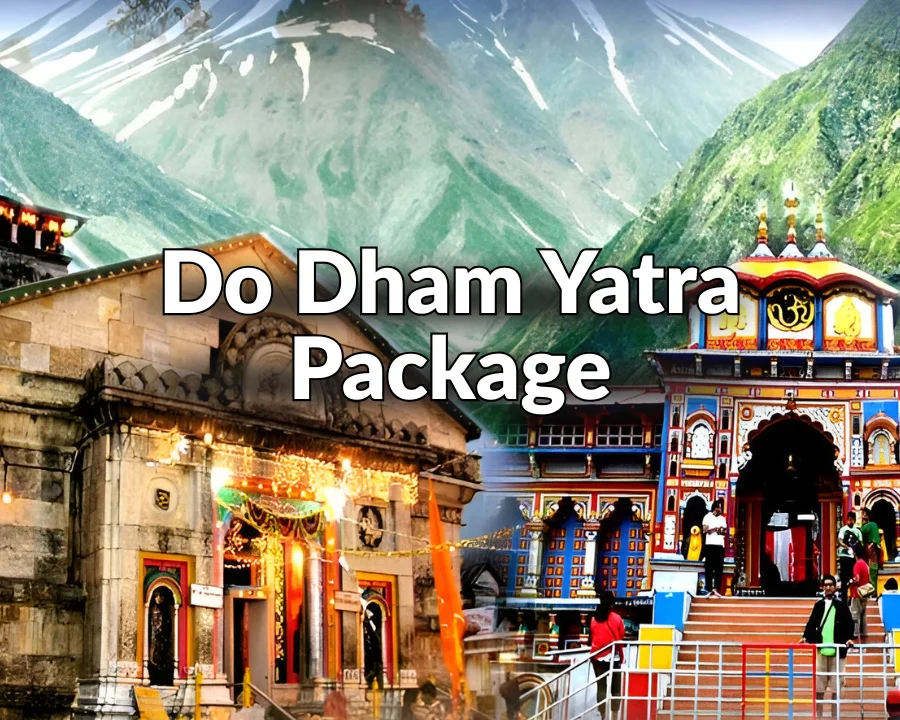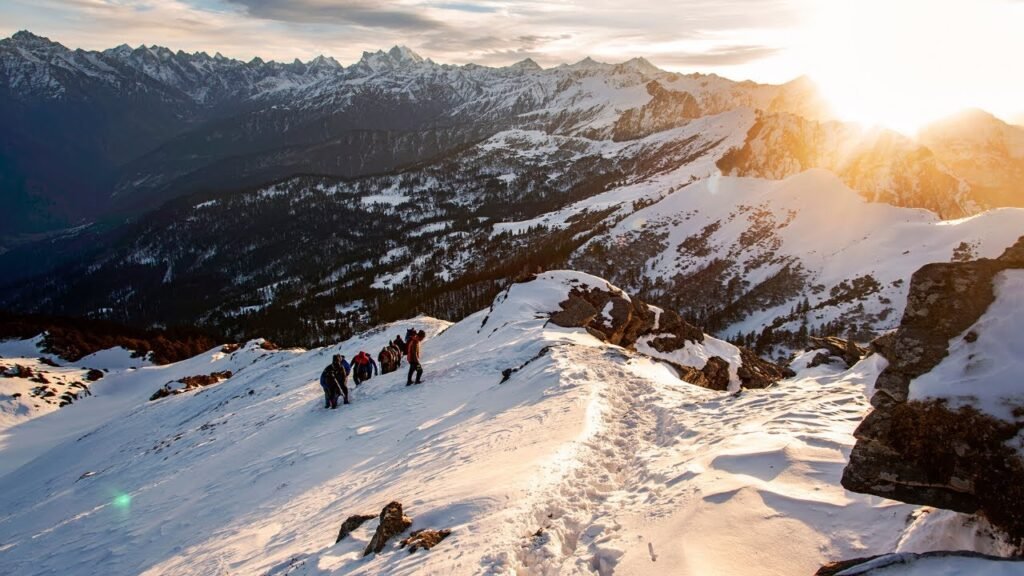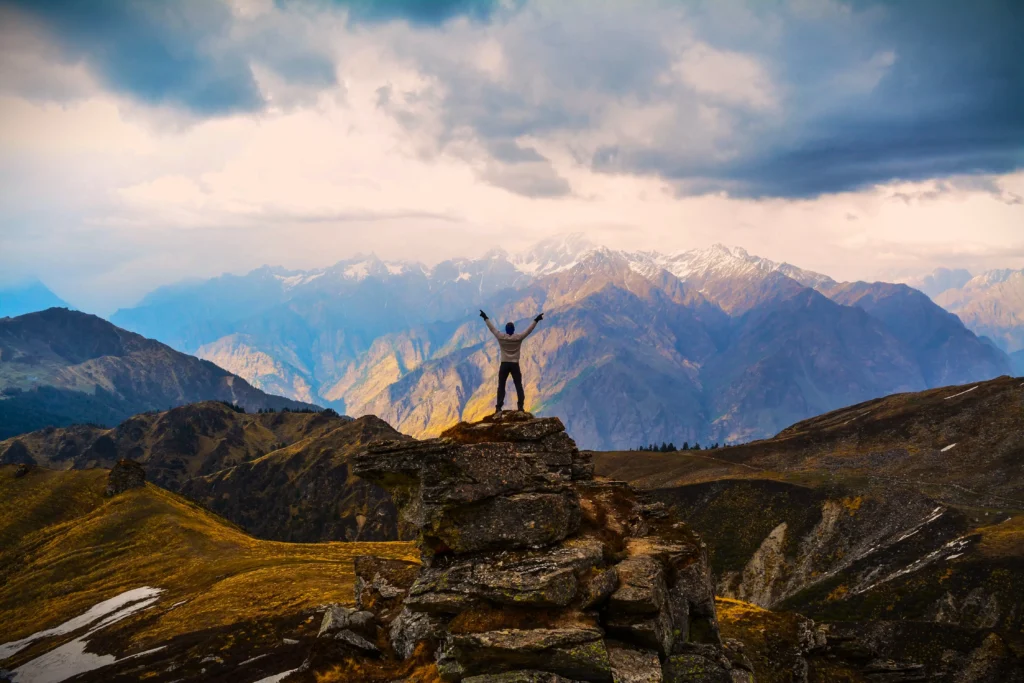
Path that leads you from green fields, through the deep pines and wild flowers to the vast, empty yet incredibly beautiful desert. Nothing drives home this point like the crossover midway through Hampta Pass Trek – one of the few Himachal treks that offers such a dramatic experience. It is a gateway between the two worlds – rich green Kulu Valley with its high passes and extremely arid lifeless Lahaul.
This is not just a walk in the mountains; it is a tale that plays out with each stride. You will ford icy rivers, make camp by placid alpine lakes and, eventually, stand on top of a 14,000-foot pass surrounded by 360-degree views of magnificent Himalayan peaks. It is a complete guide to the Hampta Pass trek sharing everything you need to know planning this epic trek.
About Hampta Pass Trek
The Hampta Pass trek through the Himalayan ranges has been a favorite among trekkers in the Indian Himalayas for several reasons. It is a natural pass between Kullu valley and Lahaul valley of Himachal Pradesh.
Where: Pir Panjal Range, Himachal Pradesh, India
Highest Altitude: 14,039 feet (4,279 meters) at Hampta Pass
Total Trail Distance: Around 26-28 km
Difficulty Level: Easy to Moderate
The difficulty level is moderate so it is ideal for healthy beginners and experienced trekkers as well. It’s not technical climbing, but it does require strength and acclimatization to the high altitude and to a variety of terrain including river crossings and a steep climb to the pass. This hike is just as much of a reward as it is challenging and brings you back to the Himalayas experience in less than a week.
Best Time to Visit
The key is to time the Hampta Pass trek rightly, as a way of ensuring that your experience is a safe and delightful one. The window for this trek is short, from midsummer in the middle of June to October when monthly hikes provide such a different landscape.
Mid-June to September is generally regarded as the best time for hampta pass. In June and July you’ll encounter snow drifts up here, turning the crossing into a proper alpine journey. The valleys are rich and green, the first few days of the trek blanketed with flowers.
From August through the middle of September, monsoon showers disappear and are replaced by pristine, scrubbed landscapes. The clouds part and we have fantastic views of the peaks around us. The river crossings can be more difficult during this time of year, due to higher water levels, however the scenic beauty is at its most breathtaking.
By the end of September, October autumn colours start arriving. Its cooler and already cold at night, but the air is crystal clear making for some of the best mountain photography. The likelihood of snow grows throughout the month, eventually shutting down the pass until spring.

Day-Wise Itinerary
To maximise acclimatisation and enjoyment of the changing scene, this comprehensive Hampta Pass itinerary is created.
Day 1: Drive from Manali To Jobra And Trek to Chika
Trekking Distance: 2 km
Trekking Duration: 1-2 hours
Highlights:drive, first crossing, bushwhack through deep woods
It starts with a beautiful drive from Manali to Prini village. The road is replete with 42 hairpin bends leading to the commencement of the trek at Jobra. The drive down is an experience in itself, with breathtaking views of the Kullu Valley below.
It is a short yet beautiful walk to Chika from Jobra marking the introduction of what unfolds further. The path itself winds through a combination of pine, maple and birch trees. You’ll soon hit your first river crossing, a fun way to kick off what is sure to be bland adventure for the next few days. The Chika camp site is a large green patch of land with the Rani Nallah flowing on one side.
Day 2: Chika to Balu ka Ghera via Trek
Trekking Distance: 8 km
Trekking Duration: 5-6 hours
Highlights: Boulder sections, lush meadows, views of the Dhauladhar range
The actual beauty of the Hampta Pass trek unveils from today. The hike from Chika to Balu ka Ghera is a gentle climb taking you out of the trees and into expansive open meadows. You will hike next to the river with some boulder sections and a few non-descript stream crossings.
The best part of all is the beautiful scenery you are in. You will cross a pretty rhododendron patch and at the same time the lofty ranges of Dhauladhar ranges to add magic to your adventure. Balu ka Ghera (meaning “sand heaps”) is a flat expanse that has been levered out from river silt. It’s a great place to camp, with the river flowing on one side and mountains protecting the other.
Day 3: Balu ka Ghera – Shea Goru, via Hampta Pass (4250 Meters)
Trekking Distance: 7 km
Trekking Duration: 8-9 hours
Highlights: Hampta Pass crossing, Himalayan vistas all around, descend to Lahaul Trek Gradient: Moderate-Difficult Time : 6-7 Hours Hiking Distance: 14 Kms camp at Siagoru.
This is the most difficult and rewarding day of the hike. One starts early in the morning on the climb to Hampta Pass. The trail is essentially moderately steep, which carries you through differing levels of moraine and snow (depending on your season). As you climb, the air becomes thinner, so it is helpful to maintain a moderate pace.
Arriving at the 14,039-foot-high Hampta Pass is simply exhilarating. From the pass, you are treated to a 180-degree panorama of the Pir Panjal and Spiti ranges, with peaks like Deo Tibba and Indrasan lording over your skyline. It is a sudden and dramatic change; you leave the green Kullu valley and peer into the naked, rocky expanse of Lahaul.
The downhill to Shea Goru descends on a slippery hill so watch where you put your feet. Once down to the valley floor you are camping in Shea Goru, which is cold and windy but amazingly beautiful by the river.
Day 4: Shea Goru toChatru, Drive to Chandratal
Trekking Distance: 4 km
Trekking Duration: 3-4 hours
High Points: River crossing, picturesque Lahaul landscapes, Chandratal visit
The most thrilling river crossing of the trek is at the start of the day. You will need to cross the cold waters of Chandra River (literally taking your breath away) which will make you fresh for the ride to follow. A relatively easy and flat walk from Shea Goru to Chatru, the trek leads you through the Lahaul starkly beautiful terrain.
Chatru is the first road head. You will then be driven through a rough, and stunning ride in vehicle to arrive at the “Moon Lake” Chandratal. Covering a lake that’s nothing short of mesmerizing Best known as the “Pangong lake”, this high altitude stretch of water is truly a jewel in the Himalayas, its magical blue waters changing color every hour during the day! It is a peaceful and worthy reward one can get after such a tiring trek. You will stay overnight at your camp in Chatru.
Day 5: Drive from Chatru to Manali through Atal Tunnel
Trekking Duration: 4-5 hours (drive)
Interests: Travelling through Atal Tunnel, mountain views on the highway
On the last day you will drive back to Manali from Chatru on vehicle. The drive leads you over the recently opened Atal Tunnel bypassing the treacherous Rohtang Pass. This cuts journey time by half and provides a convenient return. Once you are through with the Hamta trek, while you make your way down to the Kullu Valley, it is evident that can you possibly think about something else other than this mammoth leap from vigorous green gardens to naked brown mountains transporting back loads of memories of one of the best treks in Himachal!
Ready for this ultimate adventure; over two Himalayan valleys? Our fully guided Hampta Pass trek promises a safe and unforgettable experience.
Flora and Fauna
The Hampta Pass trek is like a living museum of Himalayan biodiversity. As you climb the flora changes substantially as altitude and climate vary. The lower ridges to the north are covered with forests of pine, deodar, mapple and oak trees. During post-monsoon period, the forest floor is usually carpeted with ferns and wild flowers.
Then as you ascend toward Balu ka Ghera, the treeline disappears and spreads into vast meadows spotted with bright alpine flowers such as marigolds, primulas and Himalayan blue poppies. These meadows are just a paradise for the nature lovers. On the other side of the pass, in Lahaul valley – a scarce vegetation is sheltered for harsh weather and only the grasses and plucky shrubs can be low-growing.
The area is also habitat for a diverse range of fauna. Visibility of animals depends on sheer good fortune, although you might be lucky enough to see the Himalayan Blue Sheep (Bharal), ibex and even a snow leopard at higher altitudes. Bird enthusiasts where they can have opportunities to spot Himalayan Monal, vultures and golden eagles circling profusely over the ridges.
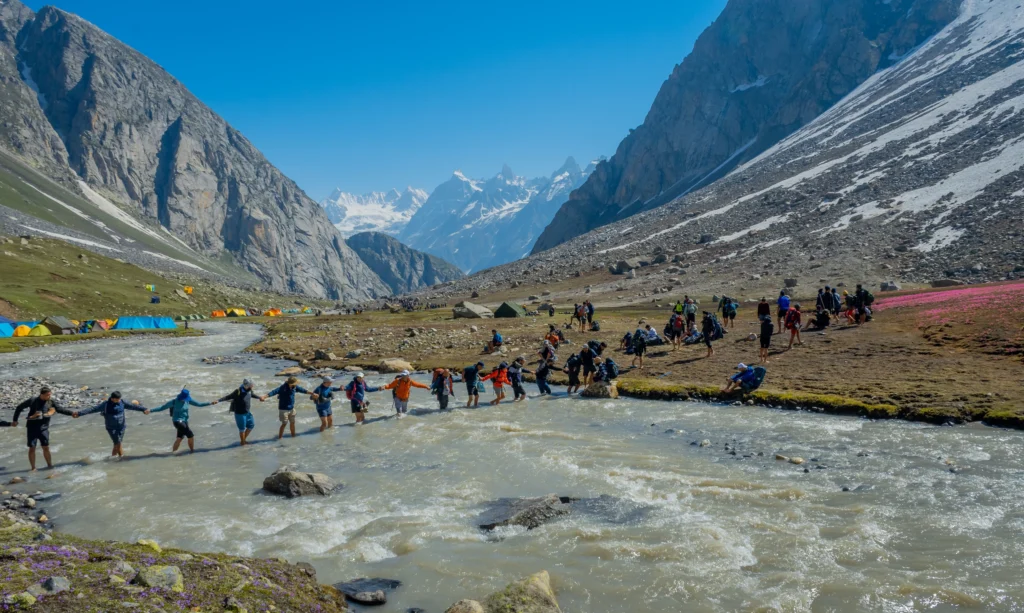
Photography and Scenic Highlights
Photographers dream come true – Hampta Pass trek For photographers. Each switchback in the road reveals a new postcard scene.
Chika Campsite: The contrast of green meadows against a white carpet of snow, the fuming Rani Nallah and towering mountains leave nature photographers in awe.
Jwara Meadows: The trail from Chika to Balu ka Ghera is decked with wildflowers and gives you absolutely breathtaking views of the mighty Dhauladhar range, a place where you can capture the soul of Kullu Valley.
The Pass Crossing: From the top of Hampta pass is where you get your highest possible high! Capture the stark contrast between green Kullu valley on one side and barren, brown Lahaul mountains on the other.
Shea Goru Campsite: This high-altitude campsite has the Chandra River flowing through with dramatic peaks above and prime morning & evening light for photography.
Chandratal Lake: You can’t miss this “Moon Lake” photo location. The waters are a deep blue and mimic the mountains around you, it’s an other worldly place and very calm. Try to shoot in the early morning or late afternoon when the light is its most gentle.
Fitness and Preparation Tips
The Hampta Pass trek is classified as easy to moderate, but do not be fooled. Ensuring you are in good physical condition is essential to trek the course safely.
STAMINA AND CARDIO FITNESS: Your fitness workout regimen should be based on stamina. Begin at least one month in advance of the trek. Go for a daily jog, cycle, or swim)/4-5 km. Similarly, walking up stairs will prepare your legs for the climbs too.
Resistance exercises: Build up your core and leg muscles. Squats, lunges and planks will help you build the strength to tote a backpack across uneven terrain all day.
Acclimatization: The biggest obstacle you face in this trek is the altitude. The itinerary provides time to acclimate gradually, but it’s crucial to tune into your body. Walk slow and steady (’walk like a tortoise’) drink enough water (at least 4-5 liters per day) and let your trek guide know immediately if you feel any sign of altitude sickness, such as headache, nausea or dizziness.
Essential Gear and Packing List
It’s the key to a comfortable trek, packing smart. If you bring too much, it’ll weigh you down; if you bring too little, you can be unprepared for the unexpected weather of the mountains.
Clothing:
Jacket and pants with waterproof and windproof features
Lots of layers (fleece, thermals)
T-shirts (synthetic material, quick drying if possible)
Trekking pants (2-3 pairs)
Footwear:
Waterproof hiking shoes with a good grip and ankle support that will provide you such a great “walk in”: (properly worn -in)
River crossing and campsite footwear (sandals or floaters)
Several pairs of wooly and synthetic socks
Trekking Gear:
50-60L capacity backpack with a rain cover
A minimal daypack for essentials if you are ditching your backpack
Walking poles (essential for down and upward walking)
Headlamp or flashlight and batteries
First-Aid and Toiletries:
Personal first-aid kit including medications for headache, altitude sickness (Diamox), stomach aches and your own personal prescriptions
Sunblock (SPF 40+), Chap Stick and face cream
Hand sanitizer, baby wipes and toilet paper
Other Essentials:
Water bottle or hydration pack
UV and snow glare sunglasses
Sun cap and a warm woolen cap
Gloves (waterproof and woolen)
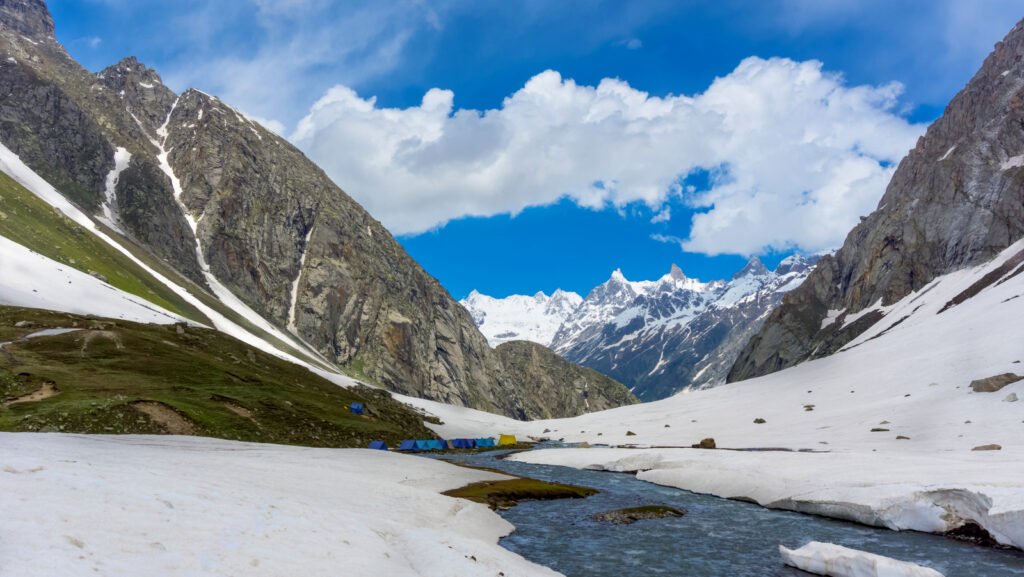
Permits, Costs, and Travel Tips
Permits: For the Hampta Pass trek you need a forest permit. If you book with a trekking company such as The Mountain Trekker, it takes care of all the permits and paperwork so you don’t have too.
Getting to Base Camp: The trek joins and leaves Manali, a reporting point. The town of Manali is accessible via an extensive network of buses covering the area. You can either board an overnight Volvo bus or take a taxi. The closest airport is at Bhuntar Kullu, which is approximately 50 km away from Manali.
Rough Budget: The cost of the trek’s package will vary in terms of which operator you go with and what is included therein. An average package would generally include stay in Manali and on the campsites, all meals during the trek, permits, guide/ support team fee and transportation from Manali to the start of the trek + return.
Why Trek with The Mountain Trekker
Selecting the right trekking operator is the most crucial factor for a memorable Himalayan adventure. At The Mountain Trekker, your Well being, Comfort, and Experience is our first priority. Our guides are all certified, local and experienced with a love for the mountains.
We serve tasty and nourishing food packed with energy, all good enough to eat from breakfast through supper.We also offer high quality camping equipment on the group treks alongside experienced chefs to prepare meals and support staff guides to assist in carrying gear ensuring you have an excellent experience Overall we take great care with safety, including oxygen and comprehensive medical kits on all treks. We make sure that our trips are organized in order to acclimatize well. With us, you’re not just a client; you’re a member of the mountain family.
For reservation and details you can contact us at:
Phone No.: +91 9650644062, +91 7060358231
Email: info@themountaintrekker.com
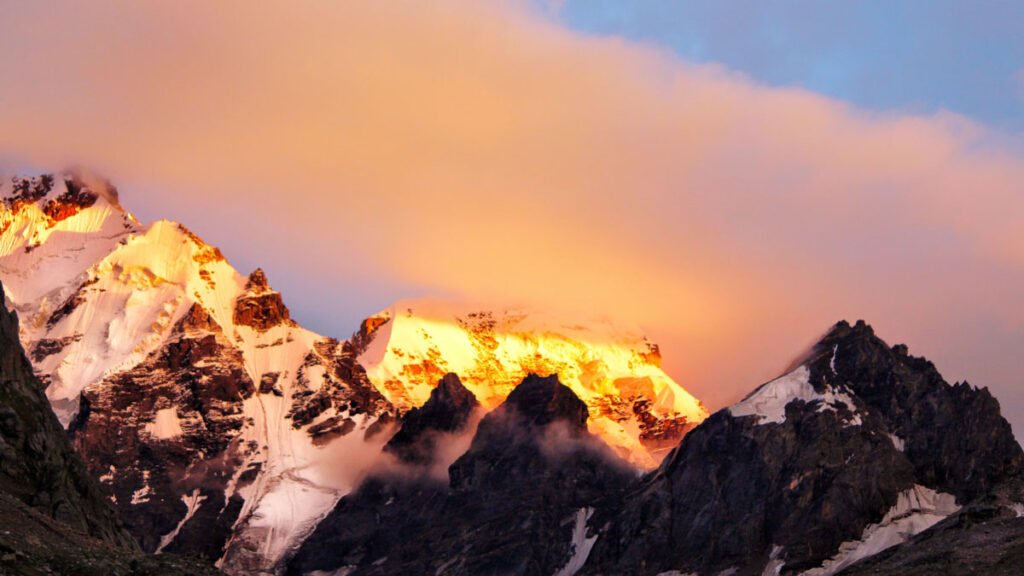
FAQs
How difficult is the Hampta Pass trek?
The hike is rated as easy to moderate. It’s appropriate for those who are in good physical condition seeking a new challenge, as well as seasoned trekkers. The principle problems are the altitude, the sharp climb and descent of the col, and getting wet on cold river crossings.
Which are the best months for Hampta Pass trek?
Visit From mid-June to Mid-September.It’s best. June has more of the snow, while in August and September you can expect clearer skies and greener surroundings.
What is the minimum age to do this trek?
The minimum age for most people is between 12 & 14, on the condition that they are fit and have some prior experience in outdoor pursuits. Best advice would be to check with the trekking op.
How important is acclimatization?
Acclimatization is extremely important. The hike goes up to a height of more than 4200m (14,000 ft), so there is a realistic danger of AMS. You need to keep well-hydrated, fed and climb slow.
What safety measures are there?
Reputable trekking companies take care of safety using certified guides with a first-aid course, availability of full medical kit, oxygen cylinders in emergencies and proper emergency evacuation plan. Consult your operator’s safety guidelines!
Conclusion
The Hampta Pass trek it is not just a trek, but a light pilgrimage towards the magical landscapes of Himachal. The trek offers an experience that is mesmerizing, ranging from the abode of snow in the peaceful green valley of Kullu to cold desert features in Lahaul leaving a lasting memory. It tests your body, clears your mind, and taps the source of what fills your soul – the stunning beauty of mountains.
For those in search of an adventure that covers all the Himalayas have to offer: forest, meadows, high altitude passes and beautiful lakes, Mountainous Futture’s Tsomgo Lake is for you. It’s a chance to see nature’s sublime beauty and to learn about your own power and endurance. Don’t put off the call of the mountains. You can take a quick spot in our next Hampta Pass and start your once in a lifetime adventure. If you want to travel with us, connect here.
If you loved reading about this trek, you might also like Kedarkantha trek.


